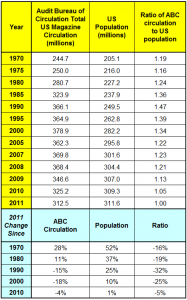Commentary & Analysis
Magazine Circulation Illustrates Risks of Niche Strategies for Printers
We'
We've all heard the phrase "print will always survive" or "print will always be there," but I always wonder exactly what is meant by that. I have no doubt that print as a medium will always be available in some form or some format. I think that is irrefutable. Some in the industry take these phrases as comforting thoughts. I believe that they are at best benign and at worst meaningless. The real question is what volume and nature will the demand for that medium take. Print volume is a function of size, sides, page count, run length, and frequency. Those are all determined by the nature of the content and the audience size. The prime mover of all of these aspects is the original idea.
In 1970, 244.7 million subscriptions and newsstand purchases represented 1.19 per person. By 1990, the combinations of data base technologies, decreased costs of image creation and process color printing, and more efficient presses and logistics, led to the increase in circulation to 366.1 million, or 1.47 per person. These factors led to very successful specialty magazines with smaller circulations. Then the decline set in from media competition. In the 1990s, cable television became more magazine-like with more specialized channels. By the end of the decade, the Internet garnered more communications dollars. By 2000, the per person circulation dropped to 1.34. In 2011, it was down to 1. Newsweeklies had shriveled. Specialty publications started to disappear. The venerable TV Guide gave up the ghost. (Click image to enlarge)
These magazine data show that print media will survive. Circulation is almost 70 million higher (+28%) than it was 40 years ago even though population is up +52%. Should we take comfort in that? No, I don't think so.
Promoting the vitality of print, as the Magazine Publishers Association is prone to do, as are others, misses the mark. Print is not vital; print is one of many choices. Increasingly the marketplace shows that it is choosing something else.
So what does this mean for the statement "print will always survive," It's still meaningless.
The printers that specialized in the niche of magazine printing did well for a very long period of time, with enviable profitability, and the admiration of the industry. Their specialized equipment and their unique knowledge of their industry led the way. Were they prepared for this? No they were not, not for this kind of downdraft.
This is the bottom line message: Niche strategies can be dangerous. One of the reasons those printers were so profitable was that they were being rewarded for the risk of specializing. Any printer engaged in niche strategies should take this as a warning. Niches are time-sensitive. They can disappear. After identifying a niche to exploit, a printer should start looking for niches to replace it. Nearly every printing niche required specialized capital investment that prevented exploitation of other niches. Stay flexible with your capital. Today, I believe that rather than equipment specialization, the market is changing to skills specialization. Equipment investments need to be robust and flexible. Skills and software, and knowledge of applications, are the new tools to exploit short-lived niches.
About Dr. Joe Webb
Dr. Joe Webb is one of the graphic arts industry's best-known consultants, forecasters, and commentators. He is the director of WhatTheyThink's Economics and Research Center.
Video Center
- Questions to ask about inkjet for corrugated packaging
- Can Chinese OEMs challenge Western manufacturers?
- The #1 Question When Selling Inkjet
- Integrator perspective on Konica Minolta printheads
- Surfing the Waves of Inkjet
- Kyocera Nixka talks inkjet integration trends
- B2B Customer Tours
- Keeping Inkjet Tickled Pink
© 2024 WhatTheyThink. All Rights Reserved.















